Biology
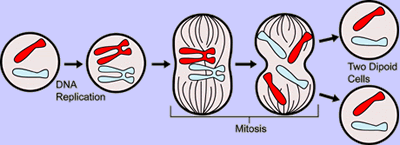
- Mitosis
Prophase Chromatin condenses to form chromosomes. Centrioles migrate to opposite poles of the cells (except in plant cells which do not have centrioles). Microtubules develop and form a star shaped structure known as an aster, and spindle fibres may develop....
- The Cell Cycle
What are all of the stages to the Cell Cycle? The Cell Cycle starts with its first stage called Interphase. The cell will be in this stage the longest amount of time out of all of the stages of the cycle. During the first part of Interphase is called...
- #80 Question 3
(a) The diagrams show a cell in various stages ofthe mitotic cell cycle. Name the stage represented by each diagram, and arrange them in the correct sequence. (b) Describe the role of spindle microtubules in mitosis. (3 marks) (c) The graph below shows...
- #32 Summary Of Cell And Nuclear Division
1. Growth of a multicellular organism is a result of parent cells dividing to produce genetically identical daughter cells. 2. During cell division the nucleus divides first, followed by division of the whole cell. 3. Division of a nucleus to produce...
- # 28.1 The Mitotic Cell Cycle - Syllabus 2015
? Replication and division of nuclei and cells ? Understanding of chromosome behaviour in mitosis Learning Outcomes Candidates should be able to: (a) explain the importance of mitosis in the production of genetically identical cells, growth, repair...
Biology
# 30 Mitosis

Mitosis is a nuclear division giving rise to genetically identical cells in which the chromosome number is maintained by the exact duplication of chromosome.
Significance of mitosis
- production of geneticlly identical cells: It keeps the chromosome number constant and genetic stability in daughter cells, so the linear heredity of an organism is maintained.
- growth: a single cell divides repeatedly to produce all the cells in the adult organism
- repair of tissue and cell replacement: produce new cells to replace ones that have been damaged (repair and generation of lost parts) or worn out (healing of wouds).
- asexual reproduction: a single parent gives rise to genetically identical offspring
The cell cycle
The cell cycle is the continuous cycle of growth and mitotic division. It has 2 major phases: Interfase and Miotic phase.
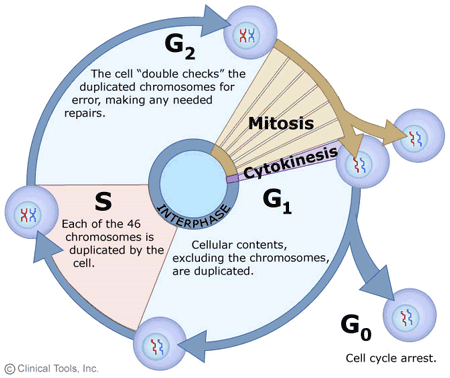
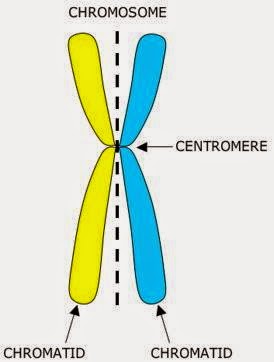
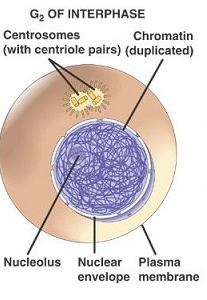
For most of the cell cycle, the cell continues with its normal activities. It also grows (produce new molecules of proteins and other substances --> increase the quantity of cytoplasm in the cell).
2. Miotic phase (M-phase): The mother cell divides into 2 genetically identical daughter cells.
a. Mitosis (nuclear division):
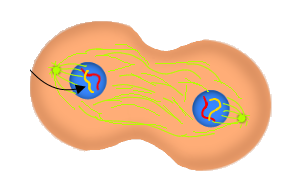
b. Cytokinesis (cell division):
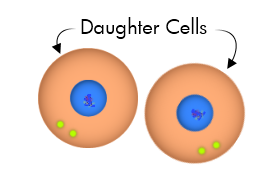
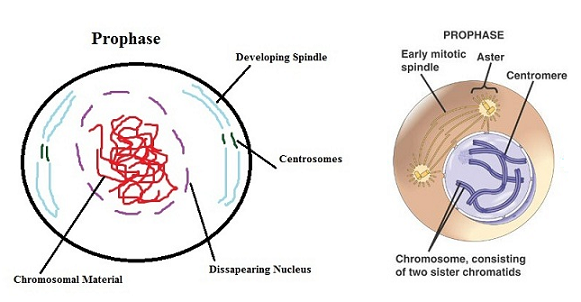
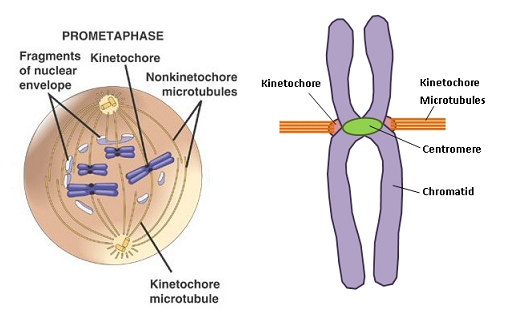
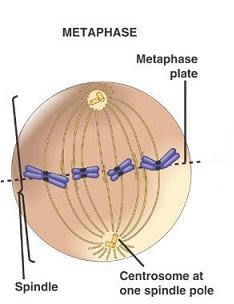
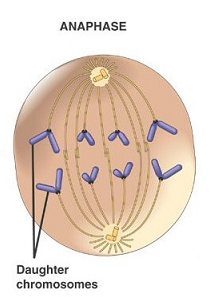
4. Telophase
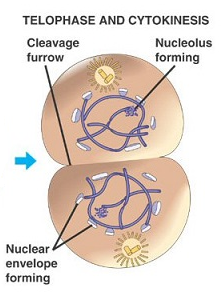
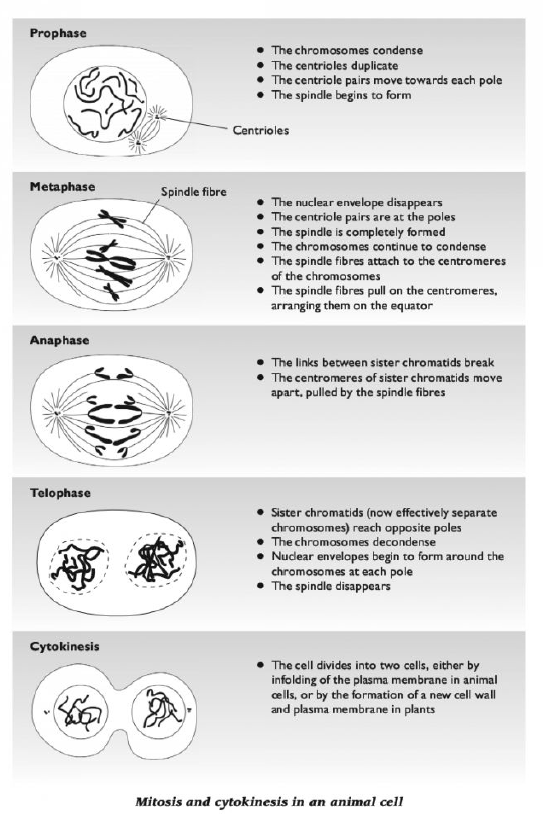
The cell cycle is the continuous cycle of growth and mitotic division. It has 2 major phases: Interfase and Miotic phase.

1. Interphase (between mitotic events) has 3 stages:
- G1-phase (Gap 1 phase): cells "monitor" their environment, and when the requisite signals are received, the cells synthesize RNA and proteins to induce growth.
- S-phase (Synthesis phase): replication of DNA. Each original chromosome has 1 DNA molecule --> after replication each chromosome has 2 identical DNA molecules (2 chromatids), they are joined together at the centromere.

- G2- phase (Gap 2 phase): cells continue to grow and prepare for mitosis. Organelles (mitochondria and chloroplasts) are replicated.

2. Miotic phase (M-phase): The mother cell divides into 2 genetically identical daughter cells.
a. Mitosis (nuclear division):
- 2 chromatids split apart and move to opposite ends of the cell.
- A new nuclear envelope forms around each group.
- These 2 nuclei each contain a complete set of DNA molecules identical to those in the original (parent) cell.
- Mitosis produces 2 genetically identical nuclei from one parent nucleus.

b. Cytokinesis (cell division):
- The cell divides into 2 daughter cells (genetically identical to each other and their parent cell).

Stages of Mitosis
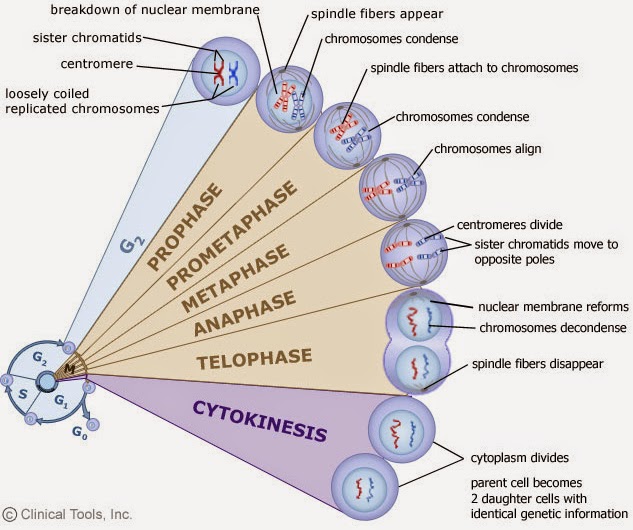

1. Prophase

- The nuclear membrane breaks down to form a number of small vesicles and the nucleolus disappears.
- The centrosome duplicates to form 2 daughter centrosomes that migrate to opposite ends of the cell.
- The mitotic spindle forms: the centrosomes organise the production of microtubules that form the spindle fibres of the mitotic spindle.
- Chromosomes become more coiled and can be viewed under a light microscope.
- Each replicated chromosome can now be seen to consist of 2 identical chromatids held by the centromere.
2. Metaphase
Prometaphase

- The chromosomes, led by their centromeres, migrate to the equatorial plane (the metaphase plate) in the mid-line of the cell, at right-angles to the axis formed by the centrosomes.
- Chromosome forms a kinetochore at each side of the centromere, to which the individual spindle fibres are attached.
- The chromosomes continue to condense.
Methaphase

- The chromosomes align themselves along the metaphase plate of the spindle apparatus.
3. Anaphase

- The centromeres divide, and the sister chromatids of each chromosome are pulled apart and move to the opposite ends of the cell, pulled by spindle fibres attached to the kinetochore regions.
- The separated sister chromatids are now referred to as daughter chromosomes.
The alignment and separation in metaphase and anaphase ensure that each daughter cell receives a copy of every chromosome.
4. Telophase

- The nuclear membrane reforms around the chromosomes grouped at either pole of the cell.
- The chromosomes uncoil and become diffuse.
- The spindle fibres disappear.

| Syllabus 2015 (a) explain the importance of mitosis in the production of genetically identical cells, growth, repair and asexual reproduction; (b) outline the cell cycle, including growth, DNA replication, mitosis and cytokinesis; (c) [PA] describe, with the aid of diagrams, the behaviour of chromosomes during the mitotic cell cycle and the associated behaviour of the nuclear envelope, cell membrane, centrioles and spindle (names of the main stages are expected); |
Syllabus 2016: 5.1 Replication and division of nuclei and cells During the mitotic cell cycle, DNA is replicated and passed to daughter cells. Stem cells in bone marrow and the skin continually divide by mitosis to provide a continuous supply of cells that differentiate into blood and skin cells. b) explain the importance of mitosis in the production of genetically identical cells, growth, cell replacement, repair of tissues and asexual reproduction c) outline the cell cycle, including interphase (growth and DNA replication), mitosis and cytokinesis 5.2 Chromosome behaviour in mitosis The events that occur during mitosis can be followed by using a light microscope. a) describe, with the aid of photomicrographs and diagrams, the behaviour of chromosomes in plant and animal cells during the mitotic cell cycle and the associated behaviour of the nuclear envelope, cell surface membrane and the spindle (names of the main stages of mitosis are expected) b) observe and draw the mitotic stages visible in temporary root tip squash preparations and in prepared slides of root tips of species such as those of Vicia faba and Allium cepa |
- Mitosis
Prophase Chromatin condenses to form chromosomes. Centrioles migrate to opposite poles of the cells (except in plant cells which do not have centrioles). Microtubules develop and form a star shaped structure known as an aster, and spindle fibres may develop....
- The Cell Cycle
What are all of the stages to the Cell Cycle? The Cell Cycle starts with its first stage called Interphase. The cell will be in this stage the longest amount of time out of all of the stages of the cycle. During the first part of Interphase is called...
- #80 Question 3
(a) The diagrams show a cell in various stages ofthe mitotic cell cycle. Name the stage represented by each diagram, and arrange them in the correct sequence. (b) Describe the role of spindle microtubules in mitosis. (3 marks) (c) The graph below shows...
- #32 Summary Of Cell And Nuclear Division
1. Growth of a multicellular organism is a result of parent cells dividing to produce genetically identical daughter cells. 2. During cell division the nucleus divides first, followed by division of the whole cell. 3. Division of a nucleus to produce...
- # 28.1 The Mitotic Cell Cycle - Syllabus 2015
? Replication and division of nuclei and cells ? Understanding of chromosome behaviour in mitosis Learning Outcomes Candidates should be able to: (a) explain the importance of mitosis in the production of genetically identical cells, growth, repair...
